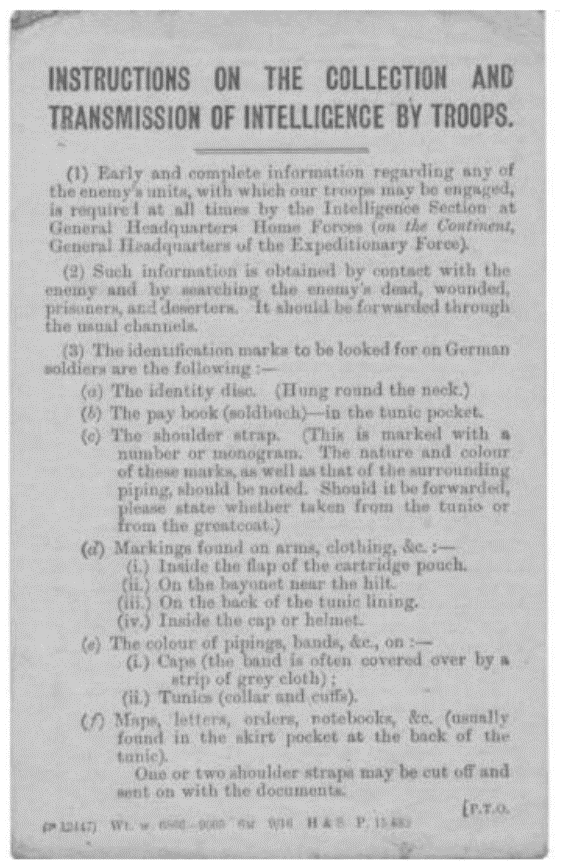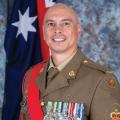'There are multiple ways an S-2 can be successful in supporting the targeting efforts of the field artillery battalion. During exercise Combined Resolve X (CBR X) at the Hohenfels Training Area, the field artillery S-2 was extremely successful in focusing on the deep fight and destroying enemy artillery assets in a timely and effective manner. Daily, the FA S-2 worked closely with the target acquisition platoon leader (TAPL) to analyse enemy artillery assets and actions. They continually assessed when and where the enemy would fire from next. In doing so, the FA battalion, in close and constant work with the brigade at the daily targeting working group (TWG), were ultimately able to influence the enemy commander’s decision cycle[1].'
 Artillery Intelligence has been a key pillar to the success of Australian operations since World War One. Observation and analysis through the art of Artillery Intelligence has been key to designing a systematic approach to counter battery operations[2]. However this niche capability has evolved beyond radars and counter battery fires. Indications, early warning and a clear battlefield understanding of enemy movements are all thanks to key Artillery people strategically placed within joint headquarters trained to view the battlefield through a green lens – having experienced a white one.
Artillery Intelligence has been a key pillar to the success of Australian operations since World War One. Observation and analysis through the art of Artillery Intelligence has been key to designing a systematic approach to counter battery operations[2]. However this niche capability has evolved beyond radars and counter battery fires. Indications, early warning and a clear battlefield understanding of enemy movements are all thanks to key Artillery people strategically placed within joint headquarters trained to view the battlefield through a green lens – having experienced a white one.
Such an important skill set cannot be lost to pages in a history book, nor left as a distant memory by an association within the RAA. Artillery Intelligence must be revitalised to support the ever changing, uncertain and undefinable threats that face our nation now and into the future.
Definition – So what is Artillery Intelligence? This art has been diluted somewhat by technology and operational tempo, moving us further and further away from our conventional roots. In order to ground us, I look to a historic piece of literature MLW 2-1-6 Artillery Intelligence Staff Duties, revised to be corps training note 1 – 2:
- Artillery Intelligence is the product resulting from collection, collation, analysis and interpretation of all available information on enemy artillery. When sufficient information has been obtained, it should be possible for the Artillery Intelligence Staff to deduced much of the following:
-
- The strength, calibre, type and disposition of the enemy artillery
- The enemy order of battle (ORBAT), boundaries and possible future intentions
- The hostile batteries (HB) most likely to interfere with any proposed operation and the likely extent of their interference.
So our end state defined, what is our aim? Returning to our previous reference:
- Provide target acquisition data on enemy artillery
- Neutralize or destroy enemy artillery in accordance with the commander’s counter-battery (CB) policy
- Provide for operations and intelligence staffs, intelligence deduced from information gathered about enemy artillery.
So Artillery Intelligence collects key pieces of information in order to provide friendly forces an insight to enemy dispositions, but more importantly, future intention.
Purpose, Manoeuvre and S2 - A lack of resources and time can ultimately bring any combat manoeuvre group to its knees. It is a staff officer’s responsibility to their commander, to develop strategies and methods to mitigate the risk of time and resources and provide the most precise and predictive intelligence to drive a timely and effective decision making process[3]. This is exactly what Artillery Intelligence strives to offer, a multi-functional cell ready to “bolt-on” to any headquarters element to enhance staff functions and reduce risk to own forces through an intelligent analysis of own and enemy positions and assets to deduce future intentions.
Lost and found – The analysis and value a well-trained artillery officer or non-commissioned officer can provide to a headquarters S2 cell is invaluable, when trained correctly in Artillery Intelligence. Having this joint knowledge allows a planning cell the opportunity to best utilise the one thing all command cells desire, time. The future of fires and manoeuvre is still greatly unclear, however the importance of artillery intelligence is not. The need to continually adapt and develop this skill set is solely dependent on the corps ability to re-invigorate this idea and find its worth again.
 When we don’t employ Artillery Intelligence we become reactionary – waiting to advance. Operations in Somalia provide an excellent example of this. Radars were employed to detect warlord artillery; however, there was none under the forces of Mohamed Farah Aideed. Farah Aideed employed technicals, mortar tubes mounted in the back of pickup trucks. Farah Aideed's crews, through the use of handheld radios, were able to bring in limited mortar fire on coalition forces. The radar system employed was the PRQ-37 and it was able to track the mortars and give the manoeuvre elements the ability to set up roadblocks and apprehend the mortar trucks. The radar further proved useful in finding heavy machine guns, rocket-propelled grenades, and air defence weapons used against coalition aircraft[4].
When we don’t employ Artillery Intelligence we become reactionary – waiting to advance. Operations in Somalia provide an excellent example of this. Radars were employed to detect warlord artillery; however, there was none under the forces of Mohamed Farah Aideed. Farah Aideed employed technicals, mortar tubes mounted in the back of pickup trucks. Farah Aideed's crews, through the use of handheld radios, were able to bring in limited mortar fire on coalition forces. The radar system employed was the PRQ-37 and it was able to track the mortars and give the manoeuvre elements the ability to set up roadblocks and apprehend the mortar trucks. The radar further proved useful in finding heavy machine guns, rocket-propelled grenades, and air defence weapons used against coalition aircraft[4].
Clearly the radars were effective but by failing to look at the information, with an intelligence mindset, coalition forces are forced to wait. But when we couple radar information with Artillery Intelligence, we can predict future intentions and be on the attack.
In short the artillery analysis – providing intellectual scrutiny, can play a continuous roll in the information preparation of the battle space giving a formation headquarters a new weapon and eventually victory.
Nurture and allow to grow - As a former XO in the G3 Office, 702d MI Group, Army Special Operations Command, at Fort Gordon, Georgia CAPT JR Johnson is very familiar with the concepts of Artillery Intelligence having been quoted as saying:
'On today's modern battlefield, the key to success is to coordinate all assets to give the maximum effect of their capabilities, and delegate the workload to all the different BOSs. No other combat arm has more eyes, ears, and radios in more places than the Artillery. No other combat arm has more organic killers and links to killer systems than the Artillery. Because of the assets and unique abilities of the FA battalion S2s, they can bring new depth and width to the brigade task force battle. At present; however, they are a vital but under-used link in the intelligence makeup of today's battlefield.'
Although I have no doubt that manoeuvre arms commanders would love to argue the point about eyes, ears and radios, my focus is on CAPT Johnson’s final point – 'At present; however, they are a vital but under-used link in the intelligence makeup of today's battlefield.'
Artillery Intelligence is a vital skill, a lifesaving skill. But like so many other skill-sets, surveillance, survey, even signals, Artillery Intelligence is gradually becoming extinct. How many more skill-sets do the RAA need to lose before we understand the importance of them? This training cannot be lost to the history books – nor left to be discussed in bar rooms or gathering halls. Artillery Intelligence most be brought back from the edge of extinction to support our nations efforts in continually fighting an adaptable and undefinable adversary.
'Duty First'









